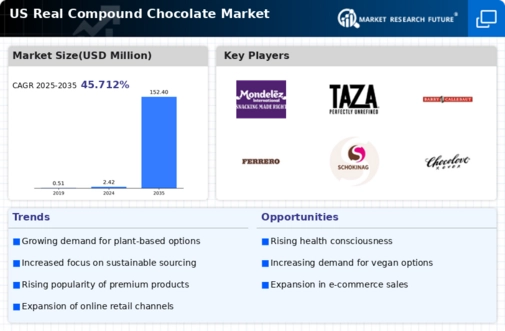Increased Snacking Culture
The rise of the snacking culture significantly impacts the real compound-chocolate market. As consumers increasingly opt for convenient and on-the-go snack options, compound chocolate products are well-positioned to meet this demand. In 2025, it is projected that snack-sized packaging will represent around 30% of total sales in the compound chocolate sector. This shift towards snacking is driven by busy lifestyles, where consumers seek quick and satisfying treats. Manufacturers are responding by offering bite-sized pieces and resealable packaging, enhancing convenience. The ability to cater to this trend allows the real compound-chocolate market to capitalize on the growing preference for snacks, ultimately driving sales and expanding market reach.
Innovative Flavor Profiles
Innovation in flavor profiles is becoming a key driver in the real compound-chocolate market. As consumer preferences evolve, manufacturers are experimenting with unique and exotic flavors to differentiate their products. This trend is particularly appealing to younger consumers who are more adventurous in their taste choices. In 2025, it is estimated that products featuring innovative flavors could account for approximately 25% of total sales in the compound chocolate segment. Flavors such as sea salt caramel, chili-infused chocolate, and fruit blends are gaining popularity, enticing consumers to explore new taste experiences. This diversification not only attracts new customers but also encourages repeat purchases, thereby contributing to the overall growth of the real compound-chocolate market.
Expansion of Retail Channels
The expansion of retail channels plays a crucial role in the growth of the real compound-chocolate market. With the rise of convenience stores, specialty shops, and online platforms, consumers have greater access to a variety of compound chocolate products. In 2025, it is projected that online sales will account for approximately 20% of total market revenue, reflecting the increasing preference for e-commerce. Retailers are also diversifying their offerings to include unique and artisanal compound chocolate brands, catering to niche markets. This broadening of distribution channels not only enhances product visibility but also encourages consumer trial, ultimately driving sales in the real compound-chocolate market.
Rising Demand for Affordable Treats
The real compound-chocolate market experiences a notable increase in demand for affordable confectionery options. As consumers seek budget-friendly alternatives to traditional chocolate, the market for compound chocolate, which is often less expensive to produce, gains traction. This trend is particularly evident among families and younger demographics who prioritize cost without sacrificing taste. In 2025, the average retail price of compound chocolate products is projected to be around $3.50 per kg, making it an attractive choice for consumers. The affordability factor is likely to drive sales, as the market adapts to meet the needs of price-sensitive shoppers. Consequently, manufacturers are focusing on optimizing production processes to maintain quality while keeping costs low, thereby enhancing their competitive edge in the real compound-chocolate market.
Growing Interest in Plant-Based Ingredients
the real compound-chocolate market is seeing increased interest in plant-based ingredients, reflecting broader dietary trends.. As more consumers adopt plant-based diets for health or ethical reasons, there is an increasing demand for chocolate products that align with these values. In 2025, it is estimated that plant-based compound chocolate could capture approximately 15% of the market share. This shift encourages manufacturers to explore alternative ingredients, such as nut butters and plant-based sweeteners, to create appealing products. By tapping into this trend, the real compound-chocolate market can attract a new segment of health-conscious consumers, thereby enhancing its growth potential.























Leave a Comment